If you work with audio in any aspect - recording, mixing, or editing - you'll need to invest in a pair of studio headphones. Whether you're recording musicians, doing critical listening prior to delivering a final mix, or editing audio in post, a good pair of studio headphones is essential.
The myriad of headphone options available can be daunting, so we've compiled a list of the best studio headphones available today, including great options for any budget. We'll also cover things to consider when choosing a pair of studio headphones.
Finally, if you're new to the studio headphones game, check out our FAQ section at the end of the article to get the lowdown on all things phoney.
What Are Studio Headphones?
Studio headphones differ from consumer grade headphones in several ways (we'll go into details in the FAQ section) , and the difference between them can mean the difference between a stellar and a mediocre finished product.
- Sound Quality: Studio headphones have a flat frequency response to give an accurate representation of the audio being listened to. This is crucial when mixing audio as nothing is artificially cut or boosted. 'Normal' headphones on the other hand often boost certain frequencies to color the sound for a more enjoyable listening experience.
- Comfort and Fit: If you've ever spent an entire day wearing a pair of headphones you'll know the importance of having a pair with a comfortable fit. Studio headphones are specifically designed to be worn for long periods of time, and are generally more comfortable than regular cans.
- Price: Studio headphones will usually set you back more than a consumer pair. The components are generally higher quality, and a lot of work has gone into making them represent the audio accurately.
Closed Back Headphones vs. Open Back Headphones
It's important to know the difference between the two main types of studio headphones, and why they matter.
Closed back headphones , as the name suggests, are closed around the ears, with extra padding over the ear cups. This avoids noise leaking from the headphones into the outside world, and to a certain extent vice versa.
If you're recording music with microphones it's essential that you avoid this spill (particularly if you're working with an artist who likes their monitor mix hot), so closed backs are the way to go.
Open back headphones on the other hand have an open back on the ear cups (you guessed it!). The openness of this design prevents any pressure build up in the ear canal, which distorts how you hear sound, particularly in lower frequencies. This makes open back headphones much better for analytical listening, and are the preferred choice for many sound engineers when performing mixing or editing duties.
The Best Studio Headphones
Since these two types of studio headphones serve different functions, we've split our list up into the two types, so you can easily find the best one to match your needs. If you're tracking, read on. If you're into editing, or mixing/mastering, skip down to the open-back reviews below.
The Best Closed Back Studio Monitor Headphones
Note that all prices listed are correct at time of writing. Take the time to shop around, and may the deal gods be with you!
1. Audio Technica ATH-M20X Closed Back Monitoring Headphones
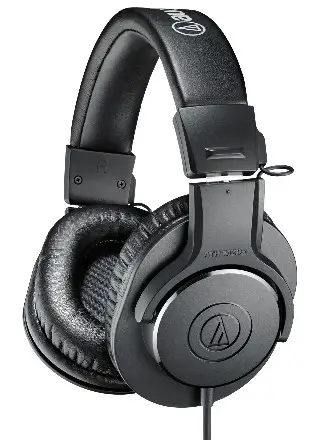
Quick Look
- Type: Closed
- Best usage: Tracking
- Impedance: 47 ohms
- Driver size: 40mm
- Frequency response: 15Hz - 20kHz
- Cable length: 9.8ft
- Detachable cable: No
- Price: $50
Audio Technica are one of the best-known names when it comes to studio headphones, and they have an impressive range of cans to suit every budget.
The M20X from the Audio Technica ATH series are the best budget studio headphones around at the moment. Perfect for entry-level studios, and those new to music production they'll make you happy with your sound while leaving your wallet feeling comfortable.
Designed for tracking and monitoring, the snug fit of these studio headphones ensures a decent amount of sound isolation - great if being used for a live studio recording. The swivel design of the ear cups make them a comfortable fit for any ear size, regardless of accessories.
Note that if you're working in hot environments the ear pads will get super-sweaty, and eventually crack. New York City gets hot in the summer. That's all I'm saying.
The M20s are tuned for enhanced low-end response. This is great for drummers and bassists, who like to have a little oomf when monitoring. But if you use them for mixing be sure to also reference your studio monitors to avoid scooping out too much low end.
Considering the affordable price, these headphones sound good. Are there better headphones out there? Yes. Can you afford them? That's up to you.
If you're looking for your first pair of studio headphones you can't really go wrong with this offering from Audio Technica.
2. Sony MDR-7506 Closed Back Professional Headphones
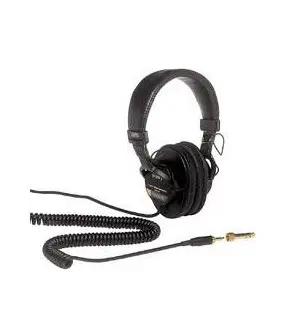
Quick Look
- Type: Closed
- Best usage: Tracking & monitoring
- Impedance: 63 ohms
- Driver size: 40mm
- Frequency Response: 10Hz - 20kHz
- Cable Length: 9.8ft
- Detachable Cable: No
- Price: $100
Walk in to any recording studio in the world and chances are you will trip over a pair of Sony MDR-7506 headphones. They were popular when they first came out in the early 90s, and they remain a staple purchase for many a studio owner today.
There's a reason why these extremely affordable studio headphones are so popular. The sound quality is consistent wherever you're recording, thanks to the impressive noise isolation, and the ear pads are comfy enough to wear the headphones for long periods of time.
They're also durable - many sound engineers boast of owning a pair for many years without having to replace them. When you consider these are collapsible phones that's quite the achievement. Better yet, if the ear padding gets a bit crusty from over-use, a replacement pair is easy to get hold of.
If you're not a fan of a coiled cable you might want to pass these by. Personally, I prefer coiled as I always seem to get in a tangled mess with straight headphone cables.
One thing to note about the MDR-7506s is the presence of a bias in the mid-range of the sound signature. They're great for monitoring, or even personal listening, but not suitable for mixing or other analytical tasks.
So if you're looking for an affordable (and comfy) pair of headphones for your monitoring duties, the Sony MDR-7506s are a tried and tested option.
3. Sennheiser HD280 Pro Closed Back Studio & Live Monitoring Headphones
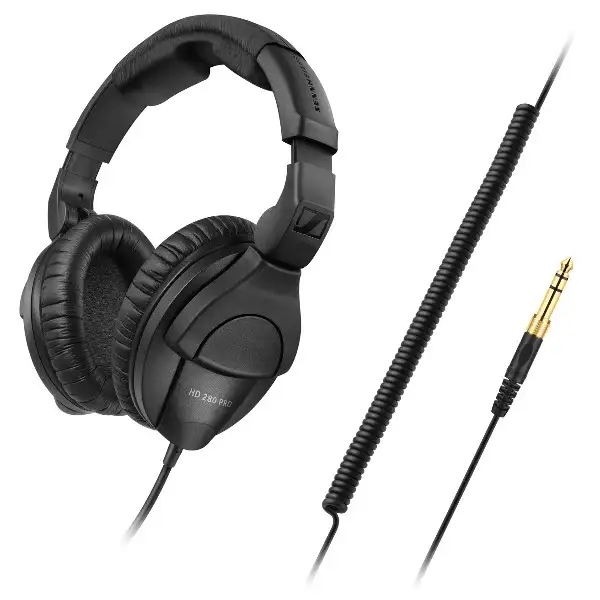
Quick Look
- Type: Closed
- Best usage: Tracking & monitoring
- Impedance: 64 ohms
- Frequency Response: 8Hz - 25kHz
- Cable Length: 9.8ft
- Detachable Cable: No
- Price: $100
Another great choice for affordable studio headphones are the Sennheiser HD280s.
Like the Sonys, these studio headphones have a coiled cable, and the ear pads are replaceable. This will set you back an additional 25% of the original cost of the headphones, but if everything else is working it's a greener option.
These headphones sound great, and despite the plasticky feel of the build they will last many years. The lightweight materials used to make these cans make them lighter than the MDRs, so if you have a particularly sensitive noggin they may be a better choice for you. In fact, many users praise the comfort factor.
The sound isolation the ear cups provide is impressive: 32dB to be exact. This makes the HD280s ideal for drummers and guitarists who love to thrash things out at the loudest volume possible. They're also great for singers who worry about sound leakage from the headphone feed bleeding into the mic.
While they do have a fairly accurate frequency response, these studio headphones are closed back, and so are better suited to monitoring rather than critical mix work. For the budget conscious, these studio headphones are a great choice.
4. Audio Technica ATH M50X
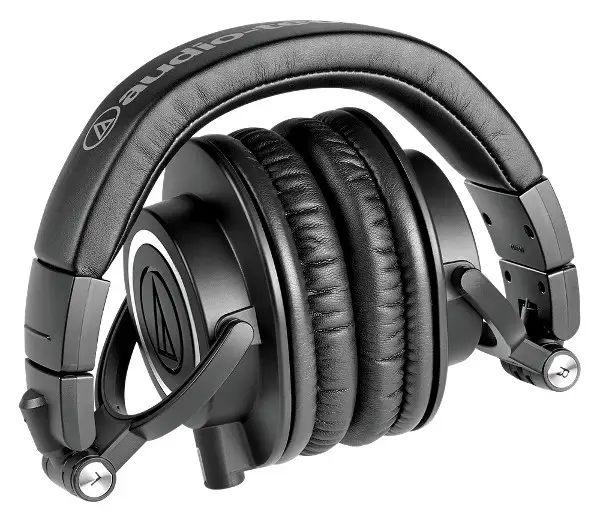
Quick Look
- Type: Closed
- Best usage: Tracking & monitoring/possibly mixing if you're on a budget
- Impedance: 38 ohms
- Driver size: 45mm
- Frequency Response: 15Hz - 28kHz
- Cable Length: 9.8ft, 3.9ft
- Detachable Cable: Yes, 3 of them
- Price: $170
Back to Audio Technica again! And for good reason; they have studio headphones to suit every budget, and now we're looking at the M50X model.
The ATH M50X headphones X are a fantastic mix of affordability and quality. The 45mm driver delivers a clear mid-range and solid bass, while maintaining a neutral frequency response. This means that while they are closed back, you could, at a push, use them as mixing headphones if you're on a tight budget.
As with the ATH M20X, the pleather covering on the ear cups can wear away and/or crack over time and extensive use, so be prepared to shell out for new cups every couple of years.
The M50X has a sister model - the Audio Technica ATH M50X BT2. For all intents and purposes this is the same pair of headphones, with the addition of wireless Bluetooth connectivity. While it's not good practice to use Bluetooth headphones for recording, if you're looking to invest in a pair of cans that will serve double duty as wired headphones in the studio and wireless ones on the subway, the Audio Technica ATH M50X BT2s might be a good choice for you.
Additionally, both models of the Audio Technica ATH M50X come with three detachable cables in varying lengths and coiliness, so say goodbye to your tangling issues.
The Audio Technica ATH M50X are a relatively affordable pair of all-round workhorse studio headphones. Not the cheapest, but by far not the most expensive, and they do a grand job of delivering a neutral sound for your listening pleasure.
5. Beyerdynamic DT700 ProX Closed Back Studio Headphones
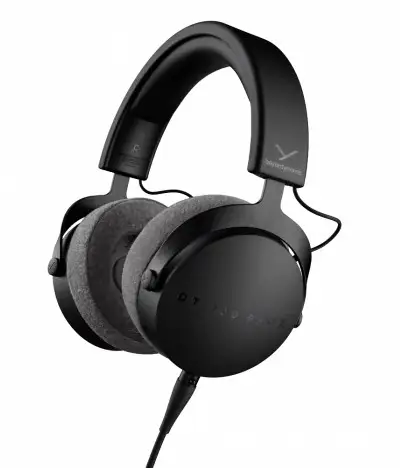
Quick Look
- Type: Closed
- Best usage: Tracking & monitoring
- Impedance: 48 ohms
- Driver size: 45mm
- Frequency Response: 5Hz - 40 kHz
- Cable Length: 9.8ft, 5.9ft
- Detachable Cable: Yes
- Price: $260
The Beyerdynamic DT700 Pro X are fairly new on the market, and a step up from the 770 Pro range. Unlike the 770 series, which is available in three different impedances, the 770 Pro X has a single, catch-all impedance (48 ohms). This makes them suitable for both studio use and personal listening, without the need for a headphone amp to drive them to sound the best.
The velour padded ear cups feel opulent on your ears, and are in fact extremely comfortable to wear for hours on end. And thanks to the strong clamping from the headband and ear cups, these headphones do a superb job at passively blocking out external noise.
This clamping may feel a little tight on your head at first, but with a week or so of use the tension in the band will loosen up enough to be comfortable.
The 700s feature newly designed STELLAR.45 drivers which deliver highly detailed, balanced sound quality, with a neutral frequency response. They also help compensate for any loss in stereo imaging, so the soundstage is wider than other studio headphones with closed backs.
The cable, headband, and ear cups are all replaceable on the 700s, suggesting a sturdy German-esque durability that promises years of listening pleasure from these headphones.
The Best Open Back Studio Headphones
1. Beyerdynamic DT900 Pro X Open-back Studio Headphones
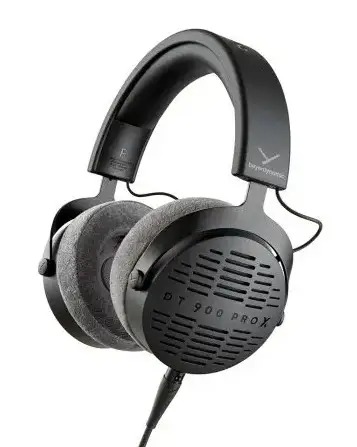
Quick Look
- Type: Open Back
- Best usage: Critical listening, mixing, mastering
- Impedance: 48 ohms
- Driver size: 45mm
- Frequency Response: 5Hz - 40 kHz
- Cable Length: 9.8ft, 5.9ft
- Detachable Cable: Yes
- Price: $260
If you're in the game for a pair of open back headphones the DT900s from Beyerdynamic are an excellent, and affordable choice.
Essentially an open-backed version of the Beyerdynamic DT700 ProX above, the DT900s feature the same Stellar.45 drivers, cozy ear cups, and replaceable parts. The open design of the cans will leak sound so it's not advisable to use them for tracking.
But the sound quality on these headphones is excellent, and they are extremely comfortable, not to mention reasonably priced.
So if you want to hear exactly how your mix sounds without spending a shoebox full of cash, the DT 900s are an excellent (and extremely comfortable) choice for the best mixing headphones.
2. Audio Technica ATH-R70X
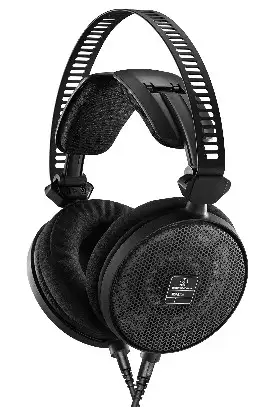
Quick Look
- Type: Open
- Best usage: Mixing audio, analytic listening
- Impedance: 470 ohms
- Driver size: 45mm
- Frequency Response: 5Hz - 40kHz
- Cable Length: 9.8ft
- Detachable Cable: Yes
- Price: $350
The Audio Technica ATH R70X studio headphones are an extremely lightweight pair of open back reference headphones.
The build quality is durable (but perhaps not enough to take on the subway commute), and the unique design of the headband makes them surprisingly comfortable to wear for hours at a time. The ear cups are large, and match the headband for comfort.
They bring a reliable sound signature to the table, with a wide frequency range, lending a certain warmth and fullness to the audio, without any darkness or muffling.
The high impedance suggests that you need an amp to get the best out of these cans, but they do work surprisingly well with standard connections. If you don't already own a headphone amp I'd suggest trying them out before splurging on any more gear, just in case your audio interface is enough .
Overall the Audio Technica ATH R70X are a reasonably priced pair of reference headphones that deliver a neutral and accurate sound, and sit pleasantly atop your noddle.
3. Sennheiser HD600 Open Back Studio Headphones
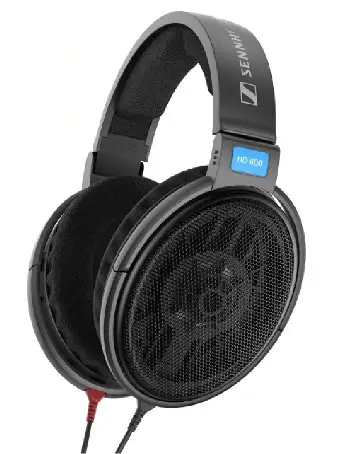
Quick Look
- Type: Open
- Best usage: Reference/classical music
- Impedance: 300 ohms
- Driver size: 42mm
- Frequency Response: 12Hz - 40.5kHz
- vCable Length: 9.8ft
- Detachable Cable: Yes
- Price: $400
Another great choice of headphones for mixing/mastering is the Sennheiser HD600. These open backed headphones have been around for over 20 years, and are still hugely popular today, particularly among engineers recording classical music.
The transparent sound is in part due to the open nature of the cups, but also thanks to the aluminum voice coils in the drivers and acoustic silk that controls airflow. The resulting sound signature is true to the original source, with no coloration or harshness at any point in the frequency range.
Many users, in fact, claim they would still buy these 'phones even if given $1000 to spend on a pair of cans. They just sound that clean.
Comfort isn't left out of the mix either (see what I did there?). The large over-the-ear cups will leave your ears feeling unscathed even after a long session, and the headband is designed to fit even the largest of heads. They can get a bit warm if you're working in heated environment, but personally I'd rather be toasty than not.
Obviously if you're using the HD600s for a personal listening experience they won't do a great job of blocking out ambient noise. But for editing and mixing in a quiet space, these fellas are a steal.
4. Neumann NDH 30 Studio Headphone
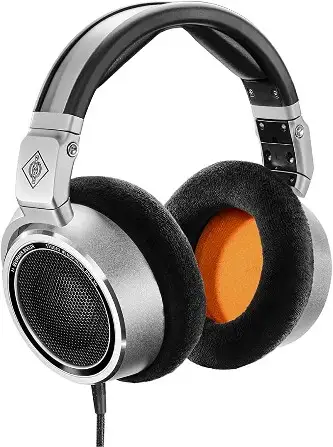
Quick Look
- Type: Open
- Best usage: Mixing & mastering
- Impedance: 120 ohms
- Driver size: 38mm
- Frequency Response: 12Hz - 34kHz
- Cable Length: 9.8ft
- Detachable Cable: Yes
- Price: $650
Neumann are best known for their world famous mics. Now they make headphones, and as you'd expect from a company that excels in sound reproduction the result is impressive.
The HD30 headphone (their website refers to these cans in the singular) was designed to capture the sound of a Neumann studio monitor set-up in a portable package. It's linear soundstage and transient response are crystal clear, with a wide stereo field.
The wide frequency range ensures that checking upper and lower extremes on a mix will translate to pretty much any system, and the neodymium magnets in the drivers prevent any coloration of the sound quality. Think: dry bass, uncluttered mids, and perspicuous highs.
The headband is constructed from flexible steel to fit even the oddest-shaped cranium, and the ear cups.... oh, those cups. The memory foam padding is not only a delight to look at but cuddles your ears like a bundle of Labrador puppies.
The incredible detail and realism in the HD30 translates to being able to hear even the slightest adjustment, even in a dense mix. It will transform your music production game, and probably make you want to go back and revisit old mixes.
The HD30 isn't cheap, but if your budget allows it's well worth the asking price.
5. Audeze LCD-X Planar Magnetic Headphones
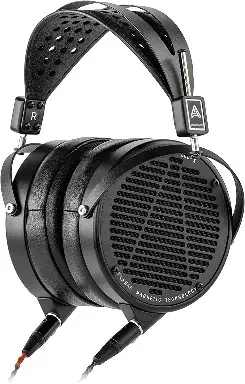
Quick Look
- Type: Open
- Best usage: Reference, mixing audio
- Impedance: 20 ohms
- Driver size: 106mm
- Frequency Response: 10Hz - 50kHz
- Cable Length: 6.2ft
- Detachable Cable: Yes
- Price: $1,200
Finally on our round-up of the best headphones for studio use are the slightly pricier LCD-X from Audeze.
The down to earth design of the LCDs may not appeal to some (especially if you're a fan of more colorful 'phones like the Focal Listen Professionals), but they are built to last, with most parts being metal.
This design does mean the headphones are heavier than some at 612g, and after an hour or so of listening you can start to feel them, but not to the point where you have to take them off.
So, if they look so dystopian, why splurge on these 'phones? Essentially, because of the planar magnetic drivers. While most headphones use dynamic drivers to keep prices down (and sales up), planar magnetic headphones have a wider frequency range, and therefore a better sound signature than others.
Interestingly, these headphones don't sound 'flat'. Instead, they conform to an equal loudness curve, designed to represent information exactly how the human ear hears it.
As a result, the balanced sound quality is flawless, with a clear bass response, balanced mids, and a warm upper range. The stereo image is so wide you'd be excused for thinking you were listening in surround.
This top-notch sound does mean you'll hear flaws in your own music that you may never have been aware of before. Ultimately that's a good thing for producers and sound engineers, and the reason the LCDs are among the best headphones for mixing and mastering.
At $1,200 they're more than 4 times pricier than the Beyerdynamic DT900s. Do they sound 4 times better? Without a doubt. If you have the money lying around these are among the best studio headphones you can get. Should you sell your mother in law to get a pair? That's up to you to decide.
Things To Consider When Looking For The Best Studio Headphones
Usage
The first thing to think about when choosing a pair of studio headphones is what they'll be used for. If you're tracking in studio environments, you'll want a pair of closed back headphones to prevent noise spill into the mic. If you will primarily be using them for audio post work (editing, analytical listening, etc.) open back studio headphones will be more comfortable for long listening sessions.
You also need to consider who's doing the listening. A drummer or bass player will benefit from having a slight boost in the lower end of the frequency range, and some headphones offer just this.
If the headphones are going to be used by multiple people, for example in a recording studio booking multiple sessions, think about the practicality of cleaning/changing the ear pads after you've had a particularly crusty drummer sticking them over their lug-holes.
If, like me, you work in audio editing you'll want a pair of mixing and mastering headphones to make sure you can hear every last detail of what's been recorded - both good and bad.
Durability
Most studio headphones are of a decent build quality, but even the sturdiest headphones will suffer being pawed by musicians day-in, day-out. Also, if you're planning on taking them out of the studio they'll need to withstand the rigors of the road.
And if they got lost or broken, would it be painful to replace them? Which leads us to...
Budget
As always, Bertie Budget should have a say in your decision making. Don't splurge more than you can realistically afford right now. But don't be a tightwad either. Get the best studio headphones that fit your budget, and you can always upgrade later when you've dominated the world with your production/audiobook editing skills.
As with most things in life, there'll be compromises to make to get to the right pair of studio headphones for you. It's not a marriage though; unlike your mother-in-law, headphone manufacturers the world over will welcome you with open arms when you're ready to upgrade.
FAQs
How are studio headphones different from consumer grade headphones?
To make for a more pleasurable listening experience, consumer headphones are designed to reproduce the classic EQ 'smiley curve', boosting higher and lower frequencies. While this is sweet for gaming, or watching The Witcher, it doesn't help when you're making music. Studio headphones are designed to deliver a more neutral frequency response, so you hear a more accurate sound.
Can I use In-Ear Monitors in a studio setting?
Technically, yes you can. Just be prepared to tip your audio engineer for setting everything up. One thing to bear in mind is that if you prefer the 'one ear on, one ear off' method of tracking with headphones in-ears make this problematic. However I'd recommend using regular studio cans for tracking unless you have a particularly snazzy pair of high quality In Ear Monitors .
I want to use my Bluetooth headphones for tracking, but the sound engineer won't let me. Why?
While Bluetooth is lovely, the technology powering it is not quite at the level where it's good to use for monitoring purposes (or live, for that matter). In addition, to some loss of audio quality over wireless transmission, there's also the issue of latency which can throw off your timing enough to make an otherwise good performance a duff one.
If humans can only hear frequencies between 20Hz-20kHz why do some headphones have a bigger frequency range?
This is, in part, because even if you can't hear a frequency you can still feel it - particularly low end frequencies. More importantly a wider frequency response results in a more accurate sound representation.
Why does driver size or type matter in studio headphones?
Drivers are the components in headphones that actually create the sound. Larger drivers have more surface area and can move more air, resulting in more low frequencies being produced.
Most studio headphones use dynamic drivers, since they're economical to produce. Planar magnetic headphones are more expensive for the consumer because the drivers (planar magnetic drivers, no less) are costly, but they do have a wider frequency response, and therefore better sound quality.
How much do studio headphones cost?
Reputable studio headphones start at around $50, and can go as high as a couple of thousand dollars. A lot of good models live in the $200-$400 range, so that's a good rule of thumb if you're trying to figure out your headphone budget.
Will I need an amp for my studio headphones?
That depends on what impedance your headphones have. Broadly speaking, high impedance headphones need more power to drive them. They are generally designed for bigger studios sending mixes through a dedicated headphone amp.
Low impedance headphones need less power and can be plugged into devices like phones, laptops, and USB audio interfaces .
Most studio headphones today will work when plugged in to a 'regular' audio output, but be aware that if the impedance of your cans is too high for the source of the audio you may experience a loss in volume, or distortion .
As a rule of thumb, any impedance under 50 ohms will run fine on your audio interface. Anything above 80 ohms is considered high impedance.
Can I use my studio headphones for listening to Harry Styles' new album?
If you insist, go ahead. But remember that studio headphones are designed to represent the entire frequency range accurately, so your good mate Harry won't have any of the audio sweetening you'll find on other headphones of the consumer variety.
I have kick-a** studio monitors and acoustic treatment. Do I really need studio headphones?
Good for you! But yes, you should still invest in a pair of good quality headphones for your studio.
For starters, if you record anything using a mic you'll need them for tracking.
Even if you only work in post-production, a pair of good studio headphones is essential for fine tuning details of the mix and other detailed listening tasks.
Why do cows wear headphones?
So they can listen to moosic. (You're welcome).





